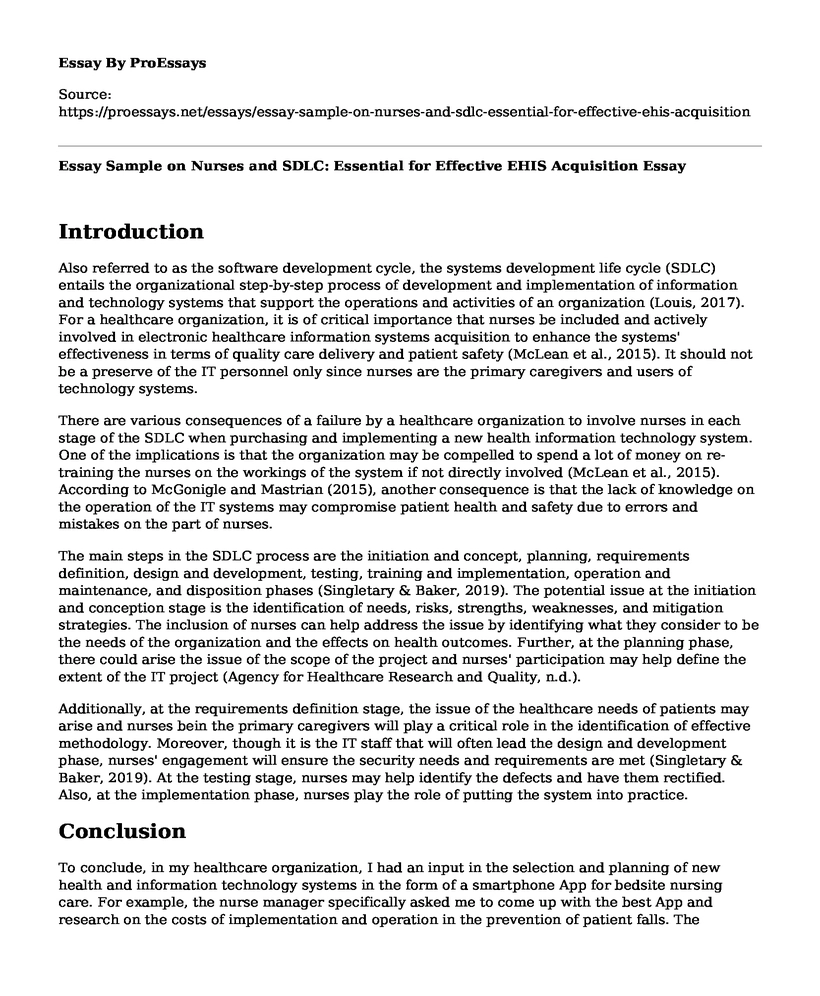Introduction
Also referred to as the software development cycle, the systems development life cycle (SDLC) entails the organizational step-by-step process of development and implementation of information and technology systems that support the operations and activities of an organization (Louis, 2017). For a healthcare organization, it is of critical importance that nurses be included and actively involved in electronic healthcare information systems acquisition to enhance the systems' effectiveness in terms of quality care delivery and patient safety (McLean et al., 2015). It should not be a preserve of the IT personnel only since nurses are the primary caregivers and users of technology systems.
There are various consequences of a failure by a healthcare organization to involve nurses in each stage of the SDLC when purchasing and implementing a new health information technology system. One of the implications is that the organization may be compelled to spend a lot of money on re-training the nurses on the workings of the system if not directly involved (McLean et al., 2015). According to McGonigle and Mastrian (2015), another consequence is that the lack of knowledge on the operation of the IT systems may compromise patient health and safety due to errors and mistakes on the part of nurses.
The main steps in the SDLC process are the initiation and concept, planning, requirements definition, design and development, testing, training and implementation, operation and maintenance, and disposition phases (Singletary & Baker, 2019). The potential issue at the initiation and conception stage is the identification of needs, risks, strengths, weaknesses, and mitigation strategies. The inclusion of nurses can help address the issue by identifying what they consider to be the needs of the organization and the effects on health outcomes. Further, at the planning phase, there could arise the issue of the scope of the project and nurses' participation may help define the extent of the IT project (Agency for Healthcare Research and Quality, n.d.).
Additionally, at the requirements definition stage, the issue of the healthcare needs of patients may arise and nurses bein the primary caregivers will play a critical role in the identification of effective methodology. Moreover, though it is the IT staff that will often lead the design and development phase, nurses' engagement will ensure the security needs and requirements are met (Singletary & Baker, 2019). At the testing stage, nurses may help identify the defects and have them rectified. Also, at the implementation phase, nurses play the role of putting the system into practice.
Conclusion
To conclude, in my healthcare organization, I had an input in the selection and planning of new health and information technology systems in the form of a smartphone App for bedsite nursing care. For example, the nurse manager specifically asked me to come up with the best App and research on the costs of implementation and operation in the prevention of patient falls. The potential impact of bein included in the decision-making process is that it enabled me to come up with a safe, secure, and efficient system that suited the needs of the organization.
References
Agency for Healthcare Research and Quality. (n.d.). Health IT evaluation tool-kit and evaluation measures quick reference guide. U.S. Department of Health & Human Services. https://digital.ahrq.gov/health-it-tools-and-resources/evaluation-resources/health-it-evaluation-toolkit-and-evaluation-measures-quick-reference.
Louis, I. (2011, August 17). Systems development life cycle (SDLC). [Video]. YouTube. https://www.youtube.com/watch?v=xtpyjPrpyX8.
McGonigle, D., & Mastrian, K.G. (2015). Nursing informatics and the foundation of knowledge (4the ed.). Burlington, MA: Jones & Bartlett Learning.
McLean, A., Frisch, N., & Roudsari, A. (2015). Nursing's voice in healthcare IT acquisition decision. Canadian Journal of Nursing Informatics, 10(3), 1-26.
Singletary, V., & Baker, E. (2019). Building informatics-savvy health departments: The systemsdevelopment life cycle. Journal of Public Health Management & Practice, 25(6), 610-611.
Cite this page
Essay Sample on Nurses and SDLC: Essential for Effective EHIS Acquisition. (2023, May 22). Retrieved from https://proessays.net/essays/essay-sample-on-nurses-and-sdlc-essential-for-effective-ehis-acquisition
If you are the original author of this essay and no longer wish to have it published on the ProEssays website, please click below to request its removal:
- Questions and Answers on Impacts that Solvents and Noise Have on Hearing
- Research Paper on Managing and Leading Change in a Health Organization
- Essay Sample on Epidemiology
- Examples of Three Presentations on Medicine and Healthcare
- Essay Example on Teen Pregnancy: An Old Challenge in a New Century
- Speech-Language Pathology: Overcoming Communication Pathologies & Achieving Max. Potential
- Paper Sample: Surprising Disease Outbreaks Spark Dream to Become a Pharmaceutical Scientist







